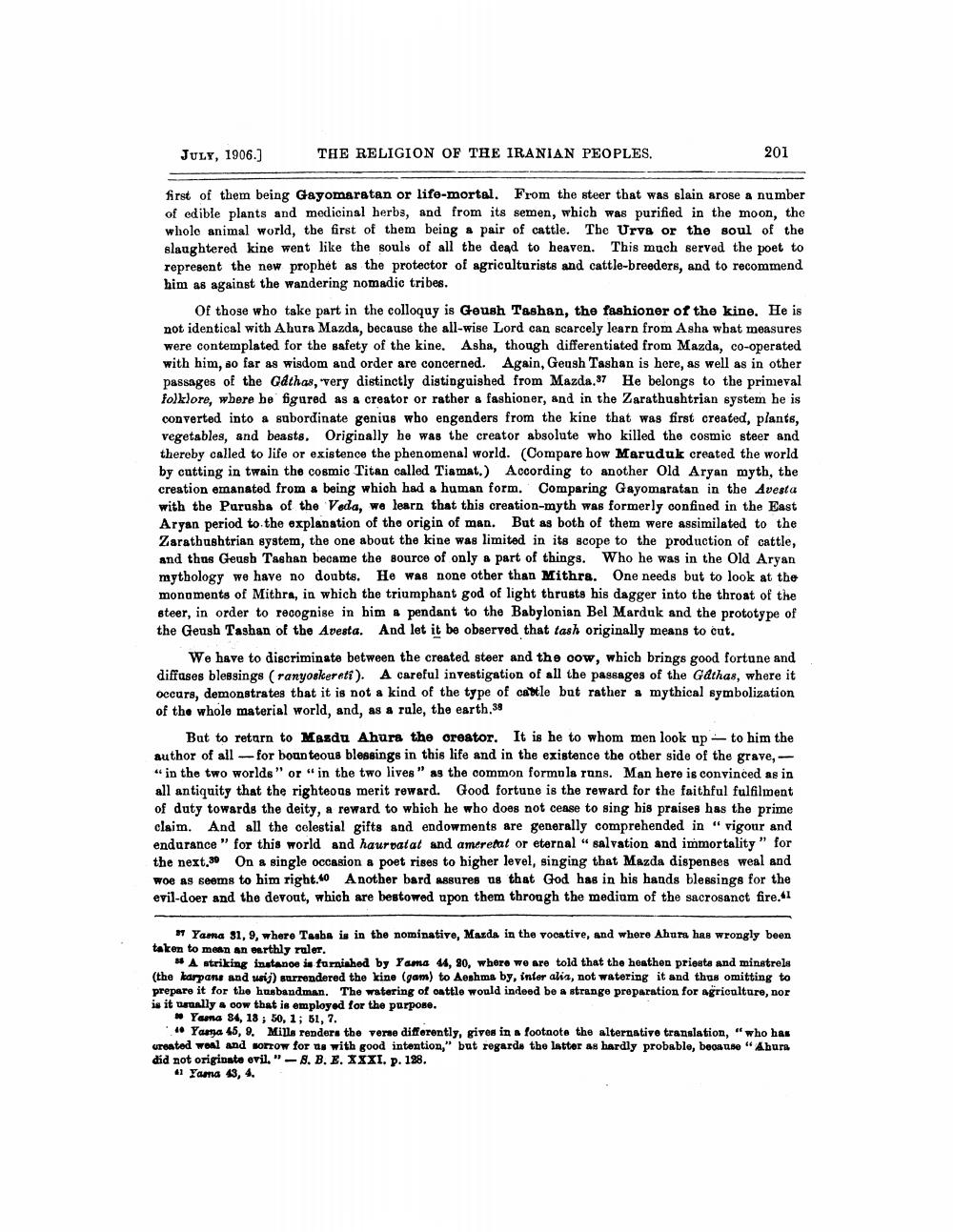________________
JULY, 1906.)
THE RELIGION OF THE IRANIAN PEOPLES.
201
first of them being Gayomaratan or life-mortal. From the steer that was slain arose a number of edible plants and medicinal herbs, and from its semen, which was purified in the moon, the wholo animal world, the first of them being a pair of cattle. The Urve or the soul of the slaughtered kine went like the souls of all the dead to heaven. This much served the poet to represent the new prophét as the protector of agriculturists and cattle-breeders, and to recommend him as against the wandering nomadic tribes.
Of those who take part in the colloquy is Geush Tashan, the fashioner of the kine. He is not identical with Ahura Mazda, because the all-wise Lord can scarcely learn from Asha what measures were contemplated for the safety of the kine. Asha, though differentiated from Mazda, co-operated with him, so far as wisdom and order are concerned. Again, Geush Tashan is here, as well as in other passages of the Gathas, "very distinctly distinguished from Mazda.37 He belongs to the primeval folklore, wbere be figured as a creator or rather & fashioner, and in the Zarathushtrian system he is converted into a subordinate genius who engenders from the kine that was first created, plants, vegetables, and beasts. Originally he was the creator absolute who killed the cosmic steer and thereby called to life or existence the phenomenal world. (Compare how Maruduk created the world by cutting in twain the cosmic Titan called Tiamat.) According to another Old Aryan myth, the creation emanated from a being which had a human form. Comparing Gayomaratan in the Avesta with the Purasba of the Veda, we learn that this creation-myth was formerly confined in the East Aryan period to the explanation of the origin of man. But as both of them were assimilated to the Zarathushtrian system, the one about the kine was limited in its scope to the production of cattle, and thus Geush Tashan became the source of only a part of things. Who he was in the Old Aryan mythology we have no doubts. He was none other than Mithra. One needs but to look at the monuments of Mithra, in which the triumphant god of light thrusts his dagger into the throat of the steer, in order to recognise in him & pendant to the Babylonian Bel Marduk and the prototype of the Geush Tashan of the Avesta. And let it be observed that tash originally means to cut.
We have to discriminate between the created steer and the cow, which brings good fortune and diffuses blessings (ranyoskereti). A careful investigation of all the passages of the Gathas, where it occurs, demonstrates that it is not a kind of the type of castle but rather a mythical symbolization of the whole material world, and, as a rule, the earth.38
Bat to return to Masdu Ahura the creator. It is he to whom men look up — to him the author of all for boun teous blessings in this life and in the existence the other side of the grave, " in the two worlds" or "in the two lives" as the common formula runs. Man here is convinced as in all antiquity that the righteous merit reward. Good fortune is the reward for the faithful fulfilment of duty towards the deity, a reward to which he who does not cease to sing his praises has the prime claim. And all the colestial gifts and endowments are generally comprehended in " vigour and endurance" for this world and haurpatat and ameretat or eternal "salvation and immortality" for the next 39 On a single occasion a poet rises to higher level, singing that Mazda dispenses weal and woe as seems to him right.60 Another bard assures us that God has in his hands blessings for the evil-doer and the devout, which are bestowed upon them through the medium of the sacrosanct fire.11
» Yama 31, 9, where Teaba is in the nominative, Mazda in the vocative, and where Ahura has wrongly been taken to mean an earthly ruler.
* A striking instance is furnished by Yama 44, 90, where we are told that the heathen priests and minstrels (the karpane and wei) surrendered the line (gam) to Aeshma by, inter alia, not watering it and thus omitting to prepare it for the husbandman. The watering of cattle would indeed be a strange preparation for agriculture, nor is it w ally a cow that is employed for the purpose.
Yamna 84, 18 ; 50, 1; 61, 7. * Yama 45, 9. Mills renders the verse differently, gives in a footnote the alternative translation, "who has created wool and sorrow for us with good intention, but regards the latter as hardly probable, because " Abura did not originate evil." - 8. B. E. XXXI. P. 188.
1 Yama 43, 4.




